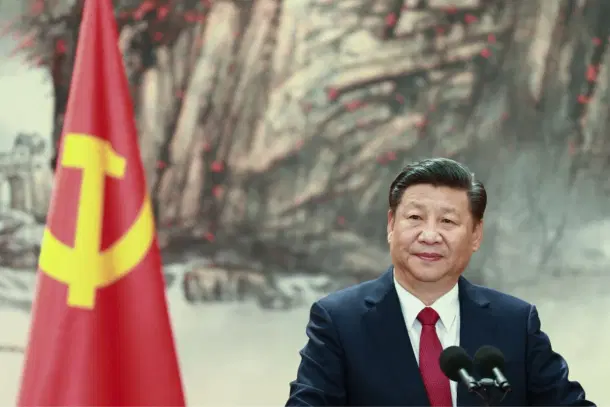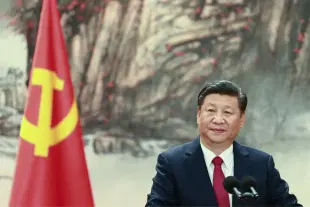News Brief
Xi Jinping’s Starlink Challenge Stalls As China’s Satellite Constellation Projects Face Launch Bottlenecks; India’s Private Sector Advances
Swarajya Staff
Jul 23, 2025, 09:22 AM | Updated 09:43 AM IST
Save & read from anywhere!
Bookmark stories for easy access on any device or the Swarajya app.


China’s effort to build its own mega-constellation of broadband satellites — akin to SpaceX’s Starlink — is facing mounting delays, technical setbacks, and deployment challenges.
Two flagship projects, the state-led Guowang and the Shanghai-backed Qianfan, are both facing delays caused by rocket shortages, sluggish deployment rates, and internal competition.
Despite President Xi Jinping reportedly instructing acceleratation of space-based communication capabilities, progress on both fronts remains far behind schedule.
Guowang: Beijing’s Official Starlink Competitor Struggles With Low Launch Cadence
The Guowang constellation, also known as Xingwang, is the Chinese central government’s official response to Starlink.
Administered by China SatNet under the state-owned aerospace conglomerate CASIC, the project envisions a network of over 13,000 satellites providing secure, high-speed internet for civilian and military use.
As of July 2025, Guowang has managed to launch only around 40 satellites.
These have been deployed in four small batches of approximately 10 satellites each, beginning in December 2024 and continuing through early 2025.
The current rate of deployment falls drastically short of what is required to meet the International Telecommunication Union’s (ITU) usage deadlines, which demand that 10 per cent of registered satellites be operational by 2026 to retain frequency rights.
The main reason for the sluggish rollout is China’s dependence on single-use Long March rockets. While Long March 6A, 8, and 5B are capable of launching LEO payloads, their availability is limited, and launch frequency is low.
Unlike SpaceX’s Falcon 9, which is reusable and launches Starlink satellites multiple times per week, China’s rockets are non-recoverable, with longer turnaround times.
The lack of a reusable launch platform has become a central bottleneck in Guowang’s development.
Qianfan: Shanghai’s Commercial Bet Undercut By State Priorities
Alongside Guowang, a separate project—Qianfan, also known as the G60 Starlink—is being developed by Shanghai Spacecom Satellite Technology (SSST), backed by the Shanghai municipal government.
Though structured more like a commercial venture, Qianfan was ambitiously planned to deploy 648 satellites by the end of 2025, scale to 1,296 by 2027 for global coverage, and eventually grow to 15,000 satellites by 2030.
To date, the project has launched 90 satellites in five missions conducted between August 2024 and March 2025.
However, at least 17 of those satellites have failed to reach their intended final orbits, according to an SCMP report.
The company had attempted to schedule nine launches carrying 162 satellites earlier this year but failed to secure viable bids from launch providers.
The technical demands—requiring rockets capable of lifting 4.5 tonnes to an 800 km orbit—could only be met by a few Long March variants, most of which are either unavailable or already committed to Guowang.
As a state-level strategic initiative, Guowang receives launch priority.
In a resource-constrained environment where launch pads and qualified rockets are limited, Qianfan has been repeatedly pushed to the sidelines.
The result is a constellation that is far off-track from its own public deployment milestones.
Xi Jinping’s Directives Add Strategic Pressure
The political urgency behind both constellations is underscored by President Xi Jinping’s direct involvement.
According to report by Kyodo News, Xi has instructed the People’s Liberation Army (PLA) to accelerate space-based communication systems in order to build a Chinese alternative to Starlink.
Beijing is particularly concerned about Starlink’s demonstrated utility in conflict zones like Ukraine, and its potential role in supporting Taiwan during a contingency.
To this end, the PLA has created a new Information Support Force, tasked with improving digital infrastructure in space and preparing countermeasures against foreign constellations.
This unit reflects Beijing’s growing anxiety over US-controlled satellite networks and the strategic imperative to build sovereign capability.
However, the political pressure from the top has not yet translated into corresponding technical breakthroughs on the ground.
India Has No State Constellation Plan, But Private Firms Are Making Steady Progress
Unlike China, India does not have a government-led plan for a satellite internet constellation of comparable scale.
However, private sector players have made substantial headway. Bharti Airtel, through its stake in Eutelsat OneWeb, is contributing to the deployment of a global LEO network.
Over 600 OneWeb satellites have already been launched, and the company is working with Indian regulators to secure spectrum and ground infrastructure approvals for regional operations.
Meanwhile, Indian startups such as Pixxel and Dhruva Space have also made successful inroads in small satellite launches and hyperspectral imaging.
India’s model contrasts sharply with China’s. Instead of pursuing orbital dominance through mass deployment, India has focused on enabling commercial players via policy support, international collaboration, and a growing space-tech ecosystem.
Also Read: China Develops Signal-Free Satellite Messaging System For Undetectable Military Communication





